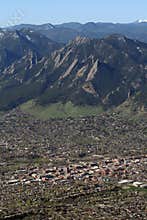A Road In Boulder, Colorado. Rocky Mountain National Park Is Located In The North-Central Region Of The U.s. State Of Colorado. It Features Majestic Mountain Views, A Variety Of Wildlife, Varied Climates And Environments—From Wooded Forests To Mountain Tundra—And Easy Access To Back-Country Trails And Campsites. The Park Is Located Northwest Of Boulder, Colorado In The Rockies, And Includes The Continental Divide And The Headwaters Of The Colorado River.the Park Contains 359 Miles (578 Km) Of Trails, 150 Lakes, And 450 Miles (720 Km) Of Streams. The Park Contains Over 60 Named Peaks Higher Than 12,000 Feet (3,700 M), And Over One Fourth Of The Park Resides Above Tree Line. The Highest Point Of The Park Is Longs Peak, Which Rises To 14,259 Feet (4,346 M; Surveys Before 2002 Show 14,255 Feet (4,345 M) The Lowest Elevations In The Park Are Montane Forests And Grassland. The Ponderosa Pine, Which Prefers Drier Areas, Dominates, Though At Higher Elevations Douglas Fir Trees Are Found. Above 9,000 Feet (2,700 M) The Montane Forests Give Way To The Subalpine Forest. Engelmann Spruce And Subalpine Fir Trees Are Common In This Zone. These Forests Tend To Have More Moisture Than The Montane And Tend To Be Denser. Above Tree Line, At Approximately 11,500 Feet (3,500 M), Trees Disappear And The Vast Alpine Tundra Takes Over. Due To Harsh Winds And Weather, The Plants In The Tundra Are Short With Very Limited Growing Seasons. Streams Have Created Lush Riparian Wetlands Across The Park.
ID 96483699725 © Puppie2008 | Megapixl.com
Your image is downloading.
Sharing is not just caring, it's also about giving credit - add this image to your page and give credit to the talented photographer who captured it.:




















































